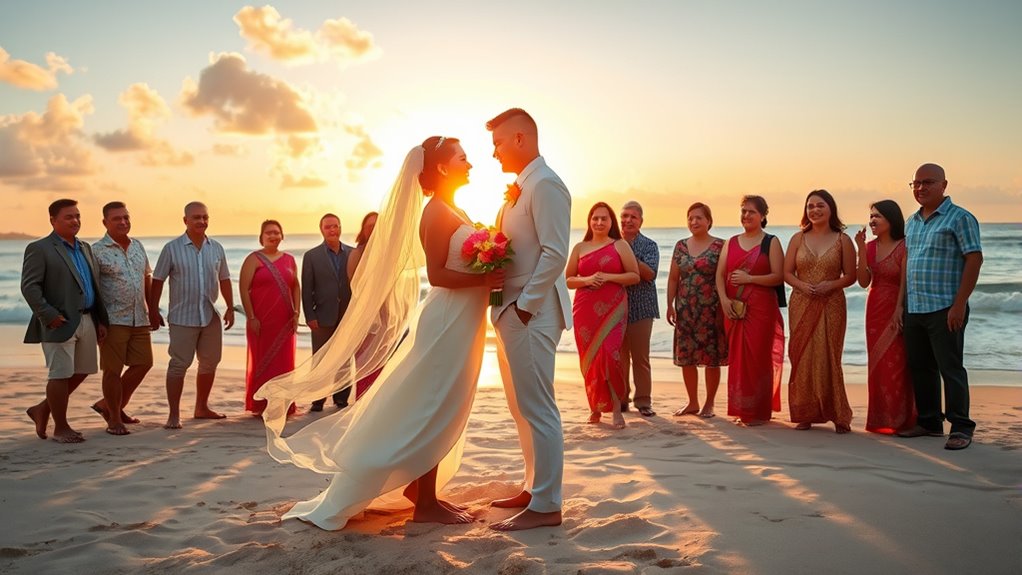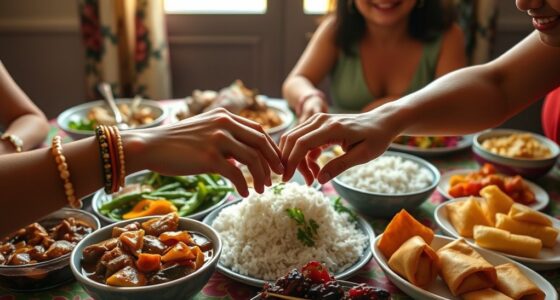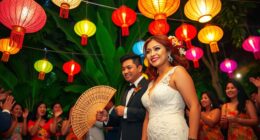Your Filipina wedding can feel like a dream come true because it embraces rich cultural traditions and meaningful ceremonies that honor your heritage. The pamamanhikan brings families together, fostering unity and love. You’ll wear stunning cultural attire like the Barong Tagalog or Filipiniana, adding elegance and pride. Simple yet significant rituals, like the coin ceremony and unity candle lighting, create unforgettable memories. There’s so much more to explore about making your day special and unique!
Key Takeaways
- The pamamanhikan ritual allowed our families to bond and offer their blessings, making the union more meaningful and respectful.
- Our cultural attire, featuring the Barong Tagalog and Filipiniana, beautifully showcased our Filipino heritage and added elegance to the celebration.
- Meaningful ceremonial traditions, like the arrhae and unity candle lighting, deepened our commitment and symbolized our unity as a couple.
- Personalizing our wedding with traditional elements and local decor created a unique atmosphere that reflected our love story and cultural roots.
- Involving our families and sponsors strengthened our relationships, ensuring that our wedding was a true celebration of love and family.
Embracing Pamamanhikan: A Beautiful Beginning
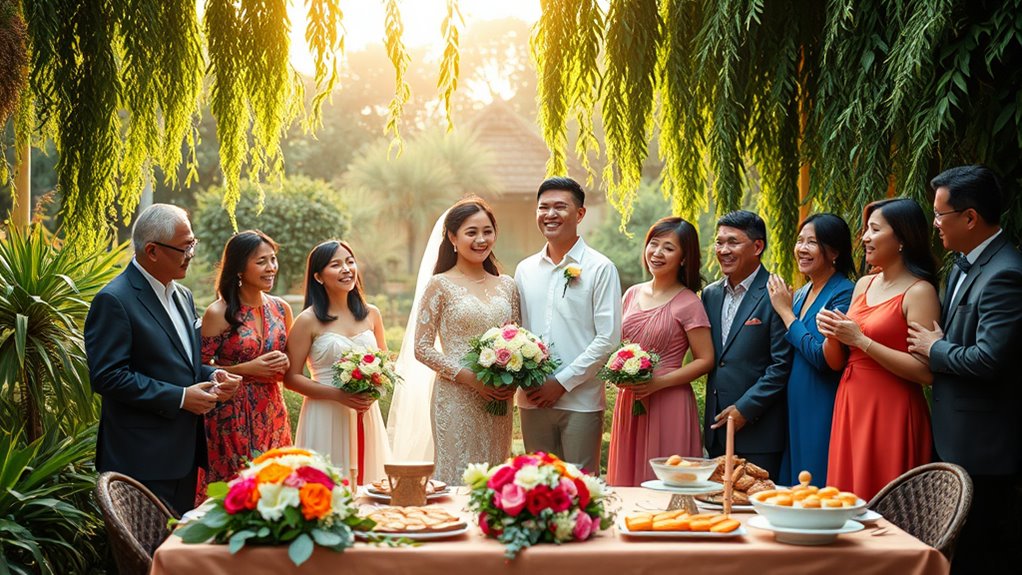
When you think about starting a life together, embracing Pamamanhikan can be a beautiful way to honor your families and traditions. This Filipino wedding custom, rooted in history, allows the groom’s family to formally ask for the bride’s hand in marriage.
It emphasizes respect and strengthens the bond between both families. During this gathering, family members are introduced, and the bride’s parents give their blessing, fostering a sense of unity.
You might bring gifts or food, or even meet at a restaurant for a meal, discussing wedding plans and future aspirations.
Embracing Pamamanhikan creates an emotional connection, making it a memorable beginning to your journey as a couple, surrounded by the love and support of your families.
The Significance of Cultural Attire
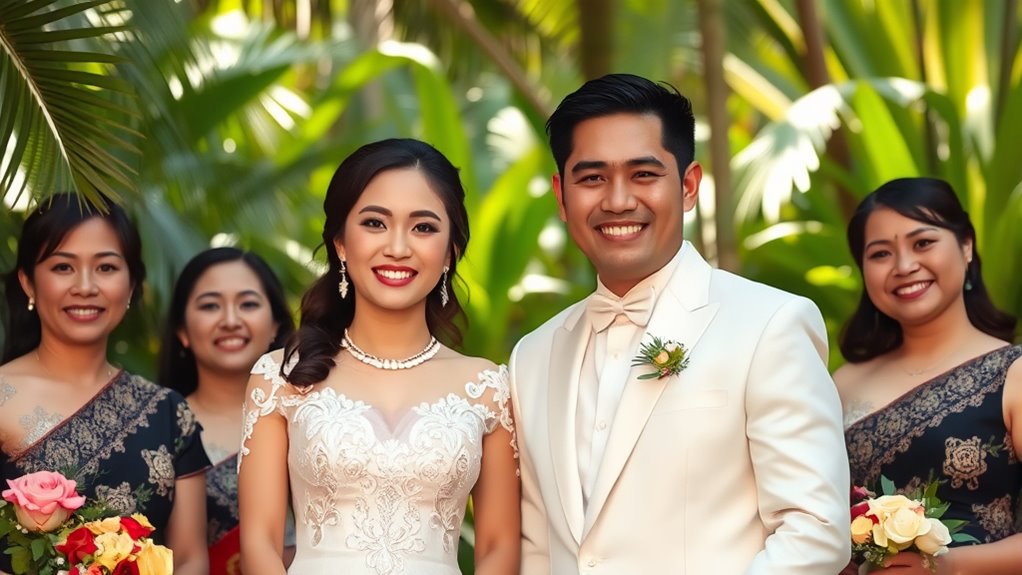
Cultural attire holds a special place in Filipino weddings, representing a deep connection to heritage and tradition. When you don the Barong Tagalog, you embrace a piece of Filipino culture that symbolizes respect and pride. Its delicate fabrics and intricate embroidery showcase the artistry of your heritage.
For brides, the Filipiniana offers an elegant counterpart, blending traditional elements with modern designs, highlighting your unique beauty. This attire not only enriches your wedding photos but also reinforces your cultural identity.
Meaningful Ceremonial Traditions

Incorporating cultural attire into your wedding sets the stage for embracing rich traditions, and the meaningful ceremonial practices that follow deepen this connection.
The arrhae, or coin ceremony, symbolizes unity and prosperity as you exchange 13 coins.
Lighting the unity candle together showcases your combined light, while the veil ceremony signifies protection under divine guidance.
The cord ceremony binds you in eternal love, representing the unbreakable bond you share.
Don’t forget the blessing of rings, a poignant reminder of your commitment.
Each of these elements reflects deep-rooted Filipino customs, merging historical significance with personal meaning, creating a tapestry of love and tradition that makes your wedding truly unforgettable.
Involving Our Families: A Celebration of Unity
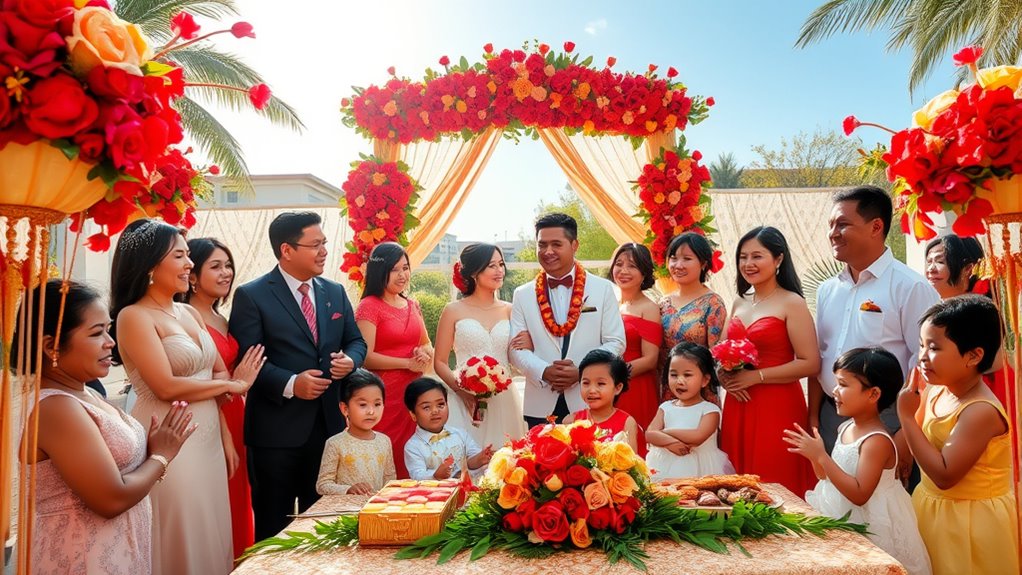
As you plan your wedding, involving your families not only enriches the experience but also highlights the unity that lies at the heart of Filipino traditions.
The pamanhikan ritual, where your families meet to discuss your union, sets the stage for a beautiful alliance. This gathering emphasizes the importance of family, allowing everyone to connect and share a feast that celebrates the occasion. In many cultures, including Filipino traditions, maintaining strong relationships is essential for emotional support during significant life events. Additionally, involving family in the planning process can foster effective co-parenting communication for those who may navigate family dynamics in the future. Planning for the future, including advance directives, ensures that family members are prepared for any eventualities. Moreover, the power of imagination can transform the planning process into a creative and joyful experience.
Seeking blessings from your parents showcases respect for elders and strengthens familial ties. Including principal and secondary sponsors, often beloved family members, in the ceremony further deepens this bond. Additionally, these traditions reflect the significance of family ties in maintaining strong relationships throughout life.
Personalizing Our Wedding Experience
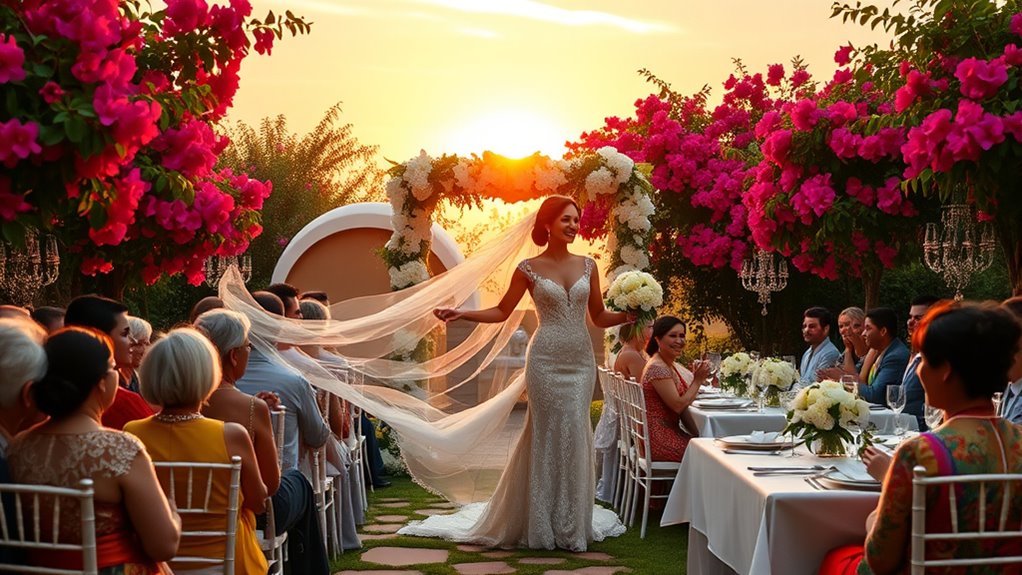
While planning your wedding, personalizing the experience can make it truly unforgettable and reflective of your unique love story.
Consider incorporating traditional elements like bamboo and rattan, along with vibrant tropical hues that resonate with Filipino heritage. Choose a venue that showcases your culture, perhaps an outdoor setting surrounded by native plants.
For decor, use bamboo centerpieces filled with orchids and hang Capiz shell lanterns for warmth. Customized wedding favors like handcrafted abanico fans can delight your guests.
Fusing Filipino Traditions With Modern Elements
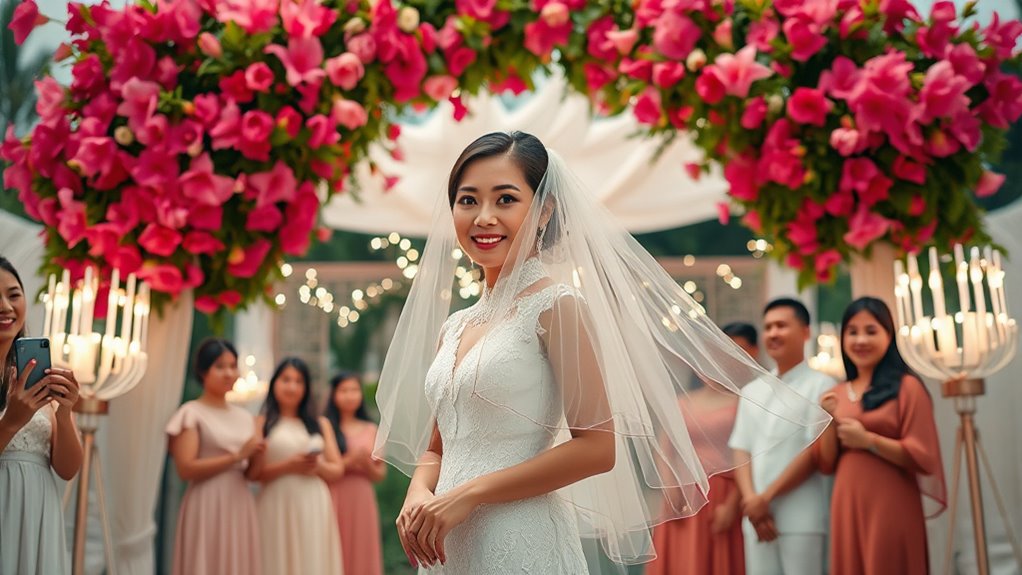
Combining Filipino traditions with modern elements can create a wedding that honors your heritage while embracing contemporary styles.
You can start by choosing a Barong Tagalog and Filipiniana, but consider modern fabrics or colors to give them a fresh twist. Incorporate ceremonial elements like the veil and cord ritual, along with the unity candle, blending tradition with modernity.
Don’t forget the thirteen coins, symbolizing commitment, which adds depth to your vows. Engage your community with a lively money dance, celebrating support from family and friends.
Finally, adapt any superstitions that resonate with you, respecting your roots while making it your own. This fusion creates a unique celebration that reflects both your cultural identity and your personal style.
Frequently Asked Questions
What Are the Costs Associated With a Traditional Filipino Wedding?
When planning a traditional Filipino wedding, you’ll face various costs. Typically, you’ll need to budget between $1,000 and $15,000, depending on guest count and services.
Venue rentals can range from ₱5,000 to ₱10,000, while food and drinks might cost ₱300 to ₱1,000 per plate.
Don’t forget entertainment expenses, such as bands or photobooths, which add to your overall budget. The size and scope of your event will heavily influence these costs.
How Long Does the Wedding Planning Process Typically Take?
The wedding planning process typically takes 12 to 18 months.
You’ll want to start by selecting a date and venue, which are essential early decisions. As you move forward, prioritize hiring a wedding planner and booking key vendors like photographers and caterers.
In the last few months, focus on final preparations, including rehearsal dinner arrangements and seating plans. Staying flexible will help you adapt to any unexpected changes along the way.
What if One Family Does Not Support the Marriage?
If one family doesn’t support the marriage, it can create significant stress for you as a couple.
You might feel torn between family expectations and your relationship. Open communication with both families is essential; try to understand their concerns.
It’s vital to establish your unity and decide how to navigate these challenges together. Seeking support from friends or a counselor could help you manage the emotional impact and strengthen your bond.
Can We Include Non-Filipino Traditions in Our Wedding?
You can absolutely include non-Filipino traditions in your wedding!
Imagine blending cultures, celebrating love, and honoring heritage. By incorporating elements like unique music, innovative attire, or special rituals, you create a ceremony that reflects both you and your partner.
Just guarantee you respect Filipino customs, engage your family, and maintain cultural sensitivity. This balance not only personalizes your experience but also fosters inclusivity, making your wedding memorable for everyone involved.
What Is the Role of the Wedding Coordinator in Filipino Weddings?
In a Filipino wedding, your wedding coordinator plays an essential role in ensuring everything runs smoothly.
They craft detailed timelines, manage vendor relationships, and oversee the setup of the ceremony and reception.
They’ll troubleshoot any issues that arise, ensuring that both you and your guests have a seamless experience.
With constant communication, your coordinator helps maintain a welcoming atmosphere, allowing you to focus on celebrating your special day without stress.
Conclusion
In the end, you might think planning a Filipino wedding would be a chaotic whirlwind of stress, but it turned out to be a beautiful journey of love and unity. Embracing our culture brought us closer, blending traditions with modern touches made the day uniquely ours, and involving family transformed what could’ve been just another event into a heartfelt celebration. Who knew that amid the chaos of wedding planning, we’d find such joy and connection?
